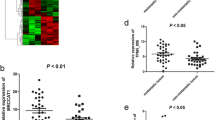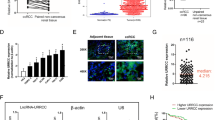Abstract
Recently, numerous studies revealed that long non-coding RNAs (lncRNAs) play complex roles in the field of tumor biology, while the functions of lncRNA in renal cell carcinoma (RCC) remain largely unknown. In the current study, we retrieved Oncomine database and found a lncRNA colorectal neoplasia differentially expressed (CRNDE) which is highly expressed in different cohorts of RCC patients; this clue reminds us that CRNDE might exert its functions in RCC tumorigenesis. We then detected the level of CRNDE in fresh RCC tissues and found that CRNDE is significantly up-regulated compared with adjacent tissues. Furthermore, both loss and gain function assays revealed that CRNDE promotes RCC cell proliferation and growth both in vitro and in vivo.
In addition, we found that CRNDE regulates the cell cycle transition from G0/G1 stage to S stage and modulates the expression of CCND1 and CCNE1. Moreover, we further illustrated that CRNDE activates Wnt/β-catenin signaling in RCC cell lines. Taken together, in the current study, we found that lncRNA CRNDE is highly expressed in RCC malignant tissues and the heightened CRNDE robustly promotes RCC cell proliferation through activating Wnt/β-catenin signaling; our findings enlarge our knowledge in the molecular pathology of RCC tumorigenesis.






Similar content being viewed by others
References
Gupta K, Miller JD, Li JZ, Russell MW, Charbonneau C. Epidemiologic and socioeconomic burden of metastatic renal cell carcinoma (mRCC): a literature review. Cancer Treat Rev. 2008;34(3):193–205.
Linehan WM, Walther MM, Zbar B. The genetic basis of cancer of the kidney. J Urol. 2003;170(6):2163–72.
Renshaw A. Subclassification of renal cell neoplasms: an update for the practising pathologist. Histopathology. 2002;41(4):283–300.
Prensner JR, Chinnaiyan AM. The emergence of lncRNAs in cancer biology. Cancer discovery. 2011;1(5):391–407.
Spizzo R, Almeida MI, Colombatti A, Calin GA. Long non-coding RNAs and cancer: a new frontier of translational research& quest. Oncogene. 2012;31(43):4577–87.
Esteller M. Non-coding RNAs in human disease. Nat Rev Genet. 2011;12(12):861–74.
Wang Y, He L, Du Y, Zhu P, Huang G, Luo J, et al. The long noncoding RNA lncTCF7 promotes self-renewal of human liver cancer stem cells through activation of wnt signaling. Cell Stem Cell. 2015;16(4):413–25.
Graham LD, Pedersen SK, Brown GS, Ho T, Kassir Z, Moynihan AT, et al. Colorectal neoplasia differentially expressed (CRNDE), a novel gene with elevated expression in colorectal adenomas and adenocarcinomas. Genes & cancer. 2011;2(8):829–40.
Wang Y, Wang Y, Li J, Zhang Y, Yin H, Han B. CRNDE, a long-noncoding RNA, promotes glioma cell growth and invasion through mTOR signaling. Cancer Lett. 2015;367(2):122–8.
Hajjari M, Khoshnevisan A. Potential long non-coding RNAs to be considered as biomarkers or therapeutic targets in gastric cancer. Front Genet. 2013;4:210.
Wang J, Zhang K, Wang J, Wu X, Liu X, Li B, et al. Underexpression of LKB1 tumor suppressor is associated with enhanced Wnt signaling and malignant characteristics of human intrahepatic cholangiocarcinoma. Oncotarget. 2015;6(22):18905–20. doi:10.18632/oncotarget.4305.
Lenburg ME, Liou LS, Gerry NP, Frampton GM, Cohen HT, Christman MF. Previously unidentified changes in renal cell carcinoma gene expression identified by parametric analysis of microarray data. BMC Cancer. 2003;3(1):1.
Yusenko MV, Kuiper RP, Boethe T, Ljungberg B, van Kessel AG, Kovacs G. High-resolution DNA copy number and gene expression analyses distinguish chromophobe renal cell carcinomas and renal oncocytomas. BMC Cancer. 2009;9(1):152.
Szafron L, Balcerak A, Grzybowska E, Pienkowskagrela B, Felisiakgolabek A, Podgorska A, et al. The novel gene CRNDE encodes a nuclear peptide (CRNDEP) which is overexpressed in highly proliferating tissues. PLoS One. 2015;10(5):e0127475.
Musgrove EA. Cyclins: roles in mitogenic signaling and oncogenic transformation: mini review. Growth Factors. 2006;24(1):13–9.
Davidson G, Shen J, Huang Y-L, Su Y, Karaulanov E, Bartscherer K, et al. Cell cycle control of wnt receptor activation. Dev Cell. 2009;17(6):788–99.
Moon RT, Bowerman B, Boutros M, Perrimon N. The promise and perils of Wnt signaling through β-catenin. Science. 2002;296(5573):1644–6.
Gupta RA, Shah N, Wang KC, Kim J, Horlings HM, Wong DJ, et al. Long non-coding RNA HOTAIR reprograms chromatin state to promote cancer metastasis. Nature. 2010;464(7291):1071–6.
Yang F, Zhang L, Huo X, Yuan Jh, D X, Sx Y, et al. Long noncoding RNA high expression in hepatocellular carcinoma facilitates tumor growth through enhancer of zeste homolog 2 in humans. Hepatology. 2011;54(5):1679–89.
Gutschner T, Hämmerle M, Eißmann M, Hsu J, Kim Y, Hung G, et al. The noncoding RNA MALAT1 is a critical regulator of the metastasis phenotype of lung cancer cells. Cancer Res. 2013;73(3):1180–9.
Xiang J-F, Yin Q-F, Chen T, Zhang Y, Zhang X-O, Wu Z, et al. Human colorectal cancer-specific CCAT1-L lncRNA regulates long-range chromatin interactions at the MYC locus. Cell Res. 2014;24(5):513–31.
Prensner JR, Iyer MK, Sahu A, Asangani IA, Cao Q, Patel L, et al. The long noncoding RNA SChLAP1 promotes aggressive prostate cancer and antagonizes the SWI/SNF complex. Nat Genet. 2013;45(11):1392–8.
Qureshi IA, Mehler MF. Emerging roles of non-coding RNAs in brain evolution, development, plasticity and disease. Nat Rev Neurosci. 2012;13(8):528–41.
Korkaya H, Paulson A, Charafe-Jauffret E, Ginestier C, Brown M, Dutcher J, et al. Regulation of mammary stem/progenitor cells by PTEN/Akt/β-catenin signaling. PLoS Biol. 2009;7(6):e1000121.
Moon RT, Kohn AD, De Ferrari GV, Kaykas AWNT. β-catenin signalling: diseases and therapies. Nat Rev Genet. 2004;5(9):691–701.
Huber O, Korn R, McLaughlin J, Ohsugi M, Herrmann BG, Kemler R. Nuclear localization of β-catenin by interaction with transcription factor LEF-1. Mech Dev. 1996;59(1):3–10.
Acknowledgments
We thank Dr. He’s for the constructive suggestions in the experiment design and the preparation of the manuscript.
Author information
Authors and Affiliations
Corresponding author
Ethics declarations
Conflicts of interest
None.
Additional information
Kun Shao and Tianming Shi contributed equally to this manuscript.
Electronic supplementary material
Figure 1S
(A) The expression of CRNDE is significantly down-regulated in 786-O and A498 cell lines. (B) Overexpression of CRNDE dramatically elevates the expression of CRNDE in HEK-293T cell lines (JPEG 174 kb)
Figure 2S
3X Flag tagged CRNDE validated the non-coding potential of CRNDE. Western blots shown that CRNDE and positive control UCA1 could not be determined by Flag antibody, while negatively control LKB1 could be examined (JPEG 68 kb)
Rights and permissions
About this article
Cite this article
Shao, K., Shi, T., Yang, Y. et al. Highly expressed lncRNA CRNDE promotes cell proliferation through Wnt/β-catenin signaling in renal cell carcinoma. Tumor Biol. 37, 15997–16004 (2016). https://doi.org/10.1007/s13277-016-5440-0
Received:
Accepted:
Published:
Issue Date:
DOI: https://doi.org/10.1007/s13277-016-5440-0




